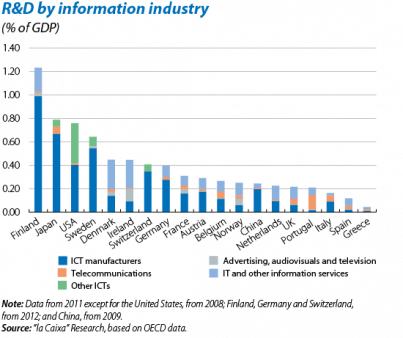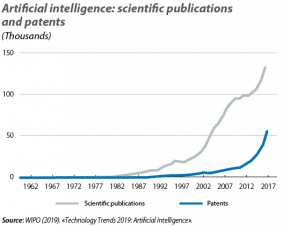The digital era and its role in the economy
The industrial revolution marked a turning point in economic history: there was a shift from the economic stagnation of several centuries to sustained growth in per capita income and an improvement in society's standards of living. This unprecedented change meant that, for example, per capita GDP in the United States grew by almost 50% in half a century. Although this is a huge increase, per capita GDP rose by the same amount in half the time as from 1980, boosted in part by the proliferation of digital technologies. These figures confirm the extent and speed of the digital revolution's effect on society, the latest revolution that is changing and will continue to change the structures of the economy as we know it. In this article we take a closer look at the macroeconomic impact of the digital revolution and the determining factors required to create an ecosystem that serves as a basis for digital expansion.
The positive effects of the digital economy can be seen on countless fronts, from increased economic activity to improved quality of life in society. The flagship of the digital revolution has been the invention of the internet, interconnecting the world and promoting globalisation. By way of example, to quantify the significance of the digital revolution for the economy, the relative weight of the internet and related sectors1 reached 3.4% of GDP in 2009 for a group of 13 countries.2 With this figure, the internet has now overtaken classic sectors such as agriculture, utilities and education and has become one of the main drivers of economic growth with a contribution of 7 pps in the 15 years prior to the crisis. This role now played by the internet and the rest of the digital technologies in economic activity has not only appeared in the «pure» sectors born in the digital revolution (for example Google and Facebook) but its impact has been felt even further, affecting all sectors. According to a report by the OECD,3 the capital of information and communication technologies (ICTs) helped to increase the value added of economic sectors as a whole by between 0.4 and 1.0 pps annually between 1995 and 2007. In addition to the direct effect of this capital as a production factor, digitalisation has also played its part in considerably improving total factor productivity, helping to generate more production with the same units of capital and labour.
These figures are even more impressive if we remember that they are based on national accounts data, a statistic that does not entirely reflect all the benefits provided by the internet and digitalisation to society. This limitation is due to the fact that GDP only reflects the production of goods and services when money is exchanged so that free goods and services are excluded from the measurement. Given that digitalisation will continue to push down the marginal cost of producing many goods and services and therefore their price, this calculation error in GDP will increase, making the figure an increasingly worse reflection of the well-being of society. For instance, a study for the US economy4 has quantified the value of these free digital services by calculating how much money consumers would have to receive for their level of well-being to be the same without using these services: this figure reaches 106 billion dollars a year, on average, between 2007 and 2011, which would correspond to an increase of 0.7 pps in GDP.
The expansion of a country's digital economy is only possible if it has a robust digital ecosystem. Specifically, the development of the digital economy will depend on three factors: digital infrastructure, human capital and institutional quality. Just as infrastructure played a key role in the first industrial revolution with the invention of the telegraph, making it easier to distribute information, and the railway network, which radically changed transport, infrastructure is also crucial for the digital revolution. Digital infrastructure consists of all the infrastructures required to support digital business, including companies that produce hardware and software, communication networks and providers of payment services and digital content. Although these infrastructures are already developed in most advanced economies, in some countries there is still a long way to go before eliminating sources of friction that limit the digital economy's growth potential. The most complex limitation is the availability of mobile spectrum (the network via which mobile data traffic moves). The allotment of spectrum needs to be unified within the European Union, thereby satisfying the increasing growth in data traffic of mobile services and improving competition and efficiency in this industry.5 Another barrier that sometimes restricts growth in the digital economy is the lack of investment in its infrastructure, highlighted by the recent debate regarding who should meet the costs, communication network providers or digital content providers, who also benefit.
There is not only a lack of investment in the infrastructures supporting the digital economy but also in digital R&D. Investment in ICT research and development in Spain is far below the rest of the countries of the euro area. This limited capitalisation in information and communication technologies can be explained by three factors: the larger share of small firms, which are less likely to innovate; the limited development of alternative financial markets such as venture capital (widely used by new technological firms) and relatively unqualified workers.
The second pillar of the digital ecosystem is human capital. While, during the first industrial revolution, a large amount of unskilled labour was required to work in factories, the quality of human capital has become more important in the new digital revolution. A knowledge of ICTs and the internet has become a basic requirement for most jobs. Specifically, in 2012, 55% of the jobs in Spain demanded a basic knowledge of computing. This change in the skills of labour in demand could accentuate polarisation in the labour market, making it difficult for some workers to find jobs, especially unskilled workers and those with skills related to very specific sectors such as construction.
The last pillar of the digital ecosystem is institutional quality. Continuing our comparison with the industrial revolution, one key element in its success was a legal regime that guaranteed the right to private property and provided suitable incentives for all economic agents. Today the function of institutions must still be one of establishing the rules of play and, in particular, safeguarding certain rights that have become even more important in the digital economy, such as protecting privacy and copyright, as well as ensuring the suitable environment to promote investment and innovation in the digital ecosystem (see the article «The challenges facing the State in the new digital economy» in this Dossier).
In short, to be able to make the most of digitalisation there must be commitment to long-term growth of the digital economy, eliminating the obstacles to expanding its infrastructures and modernising policies and regulations in order to boost investment and innovation in the digital ecosystem. Aware of its importance, the European Commission recently presented a strategy for a single digital market that aims to correct some of these obstacles and standardise regulations at a European level. This initiative is likely to be the first of many. The digital revolution has come to stay and will transform the economy as we know it.
Ariadna Vidal Martínez
Macroeconomics Unit, Strategic Planning and Research Department, CaixaBank
1. Includes internet activities by providers of telecom services, hardware and software firms and similar.
2. Study by McKinsey Global Institute, «Internet matters: The Net's sweeping impact on growth, jobs, and prosperity». The countries analysed are Germany, Canada, USA, France, Italy, Japan, United Kingdom, Russia, China, India, Brazil, Sweden and South Korea.
3. Spiezia, V. (2012), «ICT investments and productivity: measuring the contribution of ICTS to growth», OECD Journal: Economic Studies, Vol. 2012/1.
4. Brynjolfsson & Oh, «The attention economy: measuring the value of free digital services on the internet», 33rd international conference on information systems, 2012.
5. See «Delivering Digital Infrastructure. Advancing the Internet Economy», World Economic Forum and The Boston Consulting Group 2014.





